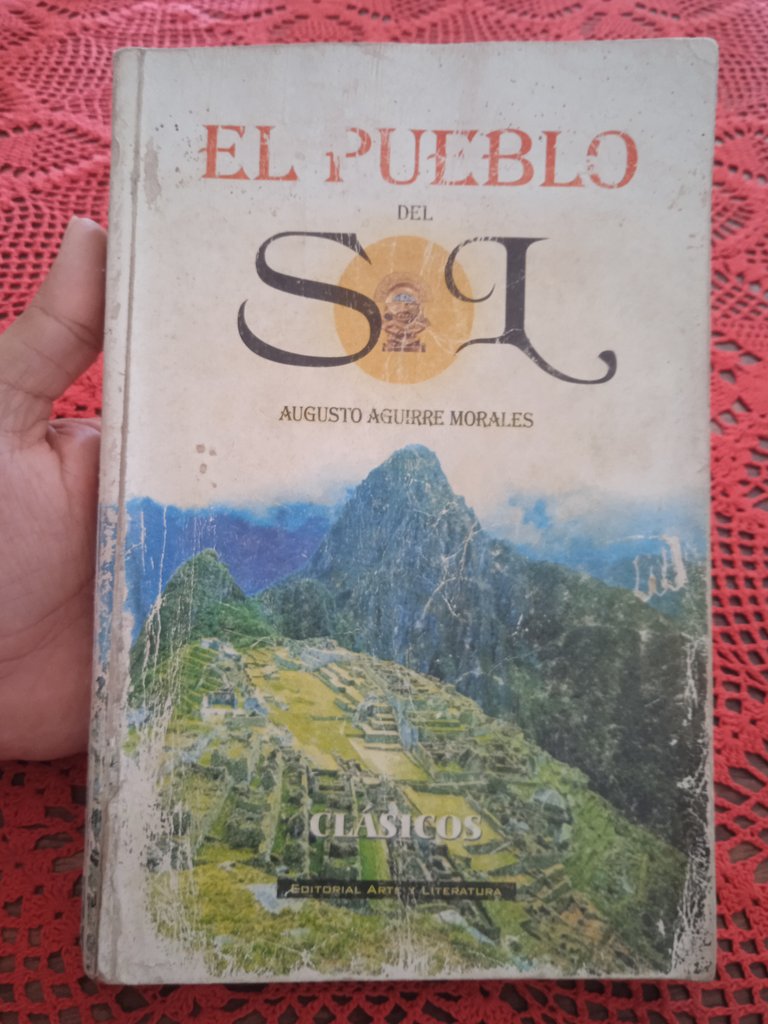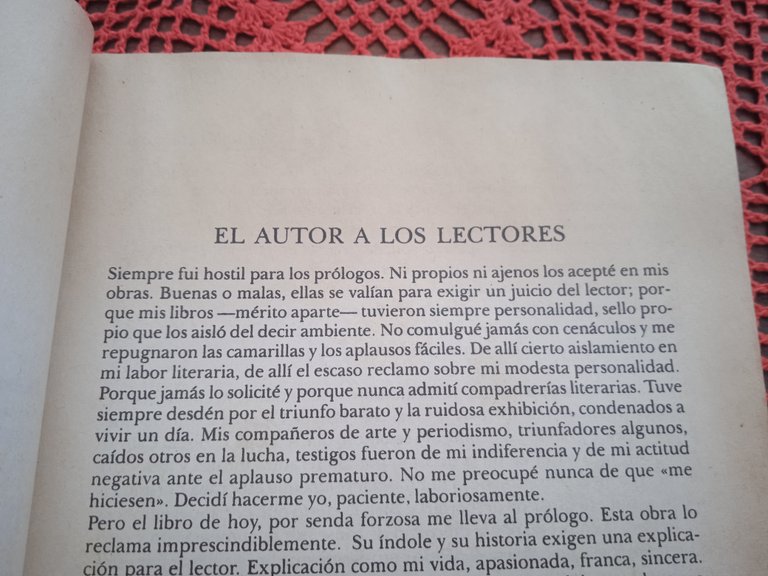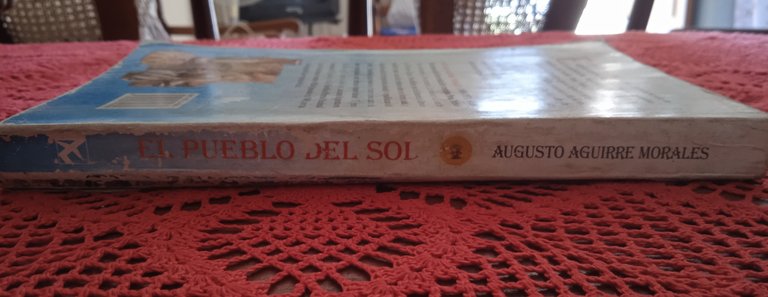Hoy quiero conversar sobre un libro que me llamó poderosamente la atención desde el momento en que llegó de segunda mano a mi posesión: El pueblo del Sol, de Augusto Aguirre Morales.
De seguro todos recordamos a los Quechuas de la época escolar, aunque llamarlos "Incas" era mucho más común en algunos lugares. El problema es que por aquellos tiempos en que era estudiante, a todos los niveles educativos imperaba una visión edulcorada, compuesta de admiración y condescendencia a partes iguales sobre su historia y legado.

Edición paperback cubana, de segunda mano.
Todo se reducía a mencionar algunos sitios arqueológicos con palabras de asombro y admirar en voz alta la resistencia que opisieron a la conquista española. Creo que romper esa imagen anquilosada e irreal fue uno de los objetivos primarios de Augusto Aguirre Morales con su obra monumental, publicada por primera vez hace casi un siglo.
Según las palabras del autor le tomó diez años escribirla y después de leerla, no seré yo quien ponga en duda tal afirmación. Se trata de una reconstrucción hilada con maestría, donde la imaginación del autor rellena los huecos dejados por los arqueólogos, pues la obra se escribió tomando en cuenta los más actualizados datos sobre los Quechuas, allá por los años veinte del pasado siglo.
Este trabajo multifacético de historador, antropólogo, etnólogo y novelista dio a luz un libro monumental, que insufla vida no solo a los Incas sino también a toda la constelación étnica que componía su imperio. La narrativa da el salto definitivo desde la "imagen con propósitos educativos" hasta la "reconstrucción plausible" de torrente poderoso y constante.

Estas palabras del autor nos dan una idea clara de su carácter e ideales en torno a su obra literaria.
Lo diré sin tapujos: no hablamos de un libro juvenil. El romance e incluso la acción, que no son ajenos a esta novela, estan tratados desde el prisma de los valores que el autor conoce o supone eran los propios de sus personajes. El realismo y la mirada libre de juicios que nos ofrece Aguirre Morales logran cautivar, pero no con florilegios y adornos superficiales.
Las costumbres incaicas fueron reflejadas con toda la transparencia y crudeza que permitieron el conocimiento disponible y el afán de retratar y no solo dibujar una caricatura. Esta es una obra que respeta la cultura que representa sin renunciar al arte literario, combina el realismo con la ficción en lo que en su tiempo fue llamado "modernismo incaico".
Algunas escenas nos harán pensar en la fibra humana que parece estar ausente de aquella vida, al mismo tiempo que nos recuerda sin decirlo que los europeos no fueron mejores en esa etapa del desarrollo de sus sociedades.

Estas ediciones baratas se deterioran rápido, pero cumplen su objetivo de brindar mayor accesibilidad a costes mínimos.
Es un libro que de muchas maneras logra ser "pedagógico" sin adoptar un tono profesoral, es más, si los profesores enseñaran como este libro los alumnos no querrían jamás abandonar los salones de clases. El libro salva otro escollo importante en mi opinión, el de lograr substraerse al exotismo banal y "turístico", estamos ante un torrente narrativo bien sopesado y efectivo sin llegar a ser efectista.
La trama es colorida, vertiginosa y con un pulso constante que captura la atención por su fuerza y compás, sin recurrir a la romantización como método para mantener interesado al lector. Como contraste me vienen a la mente obras como Faraón del polaco Boleslaw Prus, que en mi modesta opinión romantizaron demasiado, aunque sea injusta la comparación porque otros eran los objetivos y referentes de Prus.
Hoy sin dudas algunos detalles envejecieron, pues cien años no pasan por gusto y el estudio de las culturas precolombinas ha avanzado mucho. Sin embargo concluyo con una invitación a la lectura, porque a pesar de todo esta novela sigue siendo una obra cimera entre las que puedan o quieran ser similares.
ENGLISH VERSION
Today, I want to talk about a book that powerfully caught my attention from the moment a secondhand copy fell into my hands: El Pueblo del Sol (The People of the Sun) by Augusto Aguirre Morales.
Surely, we all remember the Quechua people from our school days, though in some places, calling them "Incas" was far more common. The problem is that back then, at every educational level, a sugarcoated vision prevailed, one composed of equal parts admiration and condescension toward their history and legacy.

Secondhand Cuban paperback edition.
Everything was reduced to mentioning a few archaeological sites with awe and loudly praising their resistance against the Spanish conquest. I believe shattering that rigid, unrealistic image was one of Augusto Aguirre Morales' primary goals with his monumental work, first published nearly a century ago.
According to the author, it took him ten years to write the novel, and after reading it, I won’t be the one to doubt that claim. This is a masterfully woven reconstruction, where the author’s imagination fills the gaps left by archaeologists, as the book was written using the most up-to-date data on the Quechua people available in the 1920s.
This multifaceted work combining history, anthropology, ethnology, and novelistic craft gave birth to a monumental book that breathes life not only into the Incas but also into the entire ethnic constellation that made up their empire. The narrative makes the definitive leap from an "educational-purpose image" into a "plausible reconstruction", powerful, constant and immersive.

These words from the author give a clear idea of his character and ideals regarding his literary work.
Let me be blunt: this is not a rosy young adult book. Romance and even action, though present, are treated through the prism of the values the author believes (or assumes) his characters held. Aguirre Morales captivates not with flowery embellishments but with realism and an unjudgmental gaze.
Inca customs are portrayed with transparency and rawness, as far as the available knowledge and the author’s commitment to authentic representation (rather than caricature) allowed. This is a work that respects the culture it depicts without sacrificing literary artistry, blending realism and fiction in what was once called "Incaic modernism".
Some scenes will make us reflect on the humanity that might seem absent from that era, while subtly reminding us that Europeans were no better at that stage of their own societal development.

These budget editions deteriorate quickly, but they fulfill their purpose of providing greater accessibility at minimal cost.
In many ways, this book manages to be "educational" without ever sounding professorial. In fact, if teachers taught like this book writes, students would never want to leave the classroom. It also avoids the trap of banal exoticism, this is a well-balanced, effective narrative torrent, never resorting to cheap sensationalism.
The plot is colorful, fast-paced, and rhythmically gripping, holding attention through sheer force and pacing rather than romanticization. By contrast, works like Pharaoh by the polish Bolesław Prus feel overly romanticized to me, though the comparison may be unfair, given Prus’ different goals and influences.
Today, some details have inevitably aged after all, a hundred years have passed and the study of pre-Columbian cultures has advanced significantly. Yet, I’ll conclude with an invitation to read it, because despite everything, this novel remains a peak achievement among works of its kind or any that aspire to be.
Este post es libre de IA.
📷 de mi propiedad.
This post is free of AI.
📷 are of my property.





